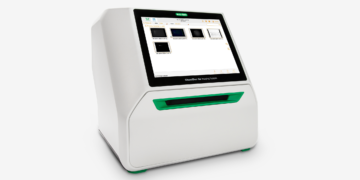
qPCR vs. ddPCR™ Assays: Select the Best Gene Expression Analysis Method for Your Application
Unsure whether to choose quantitative PCR (qPCR) or Droplet Digital™ PCR (ddPCR) for gene expression analysis? Bio-Rad’s new objective study comparing the two methods shows that the best choice depends …

Stain-Free Technology: Get Better Data in Less Time
Western blotting is a cornerstone of protein analysis—but the traditional workflow is slow, labor-intensive, and error-prone, plus it requires staining steps to visualize proteins on a gel or blot. Stain-Free …

Real-World AAV Empty-Full Capsid Analysis with ddPCR Technology: Insights from Matica Biotechnology
Vericheck ddPCR Empty-Full Capsid Kits for AAV Workflows Measuring the ratio of empty to full capsids serves as a critical quality attribute (CQA) for adeno-associated virus (AAV) products and directly …

10 Tips for Optimizing High-Throughput Flow Cytometry Assays
Flow cytometry can be labor intensive, and efforts to increase throughput can lead to reduced data quality or even instrument reliability issues such as blockages. While some instruments are more …

Advancements in CMOS Sensors for Scientific Imaging
For years, CCD sensors, known for their high-quality imaging capabilities, have been the gold standard in scientific instrumentation. However, recent advancements in CMOS sensors have positioned them as a cost-effective and competitive alternative that is quickly gaining traction in the field. In this article, we delve into the strengths and applications of CCD and CMOS sensors, exploring how this shift in technology is reshaping the digital imaging landscape.

As Easy as 1, 2, 3: Achieving Purification Success with a New Two-Mode Chromatography Resin
A common misconception is that stronger is always better. However, Nuvia wPrime 2A Media, a weak anion exchange hydrophobic interaction (AEX-HIC) mixed-mode chromatography resin, has won over purification scientists. Read about diverse use cases for Nuvia wPrime 2A Media and see the data for yourself.

Navigating Change: Public Health Labs Are Adapting to New Regulations for Laboratory-Developed Tests
Labs face a growing compliance burden and increased uncertainty due to new regulations surrounding laboratory-developed tests (LDTs). The U.S. FDA’s final rule and Supreme Court’s recent decision to overturn the Chevron doctrine are creating a complex regulatory environment that challenges the ability of public health labs to rapidly respond to emerging pathogens. This article explores the implications of these changes and more.

Saving Lives: Innovative Therapeutic Applications of Ion Exchange Resins
Although chromatography resins are usually thought of as tools to purify medicines, groundbreaking treatments now utilize resin beads as an integral component of the therapy itself. These therapies are essential for treating certain cancers and inflammatory disorders.

The Journey from Lab to Clinic: Zolgensma, the First Gene Therapy Treatment for Spinal Muscular Atrophy (SMA)
Translational research bridges the gap between scientific discoveries and real-world applications, transforming scientific breakthroughs into life-changing therapies. Success in this endeavor hinges on several factors, including collaboration between scientists and clinicians. A notable example of this is the approval of Zolgensma, a gene therapy for spinal muscular atrophy (SMA), which marked a significant milestone in the field of translational research.

Vive la Différence: The Beauty of Diversity in Life, Life Science, and Flow Cytometry
The differences between us are what makes life interesting, and diversity in a group that shares a common goal can lead to many benefits. Here we examine the similarities and differences between researchers using flow cytometry for academic research and those using it for drug discovery. We outline the challenges they face and learn that they share a common goal as well as a common solution.
